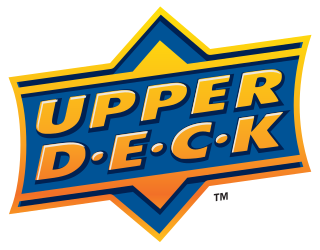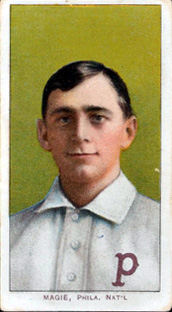
In the field of computing, a printer is considered a peripheral device that serves the purpose of creating a permanent representation of text or graphics, usually on paper. While the majority of outputs produced by printers are readable by humans, there are instances where barcode printers have found a utility beyond this traditional use. Different types of printers are available for use, including inkjet printers, thermal printers, laser printers, and 3D printers.

Garbage Pail Kids is a series of sticker trading cards produced by the Topps Company, originally released in 1985 and designed to parody the Cabbage Patch Kids dolls, which were popular at the time.

A trading card is a small card, usually made out of paperboard or thick paper, which usually contains an image of a certain person, place or thing and a short description of the picture, along with other text. There is a wide variation of different types of cards.

A baseball card is a type of trading card relating to baseball, usually printed on cardboard, silk, or plastic. In the 1950s, they came with a stick of gum and a limited number of cards. These cards feature one or more baseball players, teams, stadiums, or celebrities.

Business cards are cards bearing business information about a company or individual. They are shared during formal introductions as a convenience and a memory aid. A business card typically includes the giver's name, company or business affiliation and contact information such as street addresses, telephone number(s), fax number, e-mail addresses and website. Before the advent of electronic communication, business cards also included telex details. Now they may include social media addresses such as Facebook, LinkedIn and Twitter. Traditionally, many cards were simple black text on white stock, and the distinctive look and feel of cards printed from an engraved plate was a desirable sign of professionalism. In the late 20th century, technological advances drove changes in style, and today a professional business card will often include one or more aspects of striking visual design.

Notaphily is the study and collection of paper currency, and banknotes. A notaphilist is a collector of banknotes or paper money, particularly as a hobby.

The Upper Deck Company, LLC, founded in 1988, is a private company primarily known for producing trading cards. Its headquarters are in Carlsbad, California, United States.

Mint condition is an expression used to denote the quality of a pre-owned good as displaying virtually no imperfections and being in pristine condition relative to its original production state. Originally, the phrase related to the way collectors described the condition of coins. As the name given to a coin factory is a "mint", then mint condition is the condition a coin is in when it leaves the mint.

A flattop is a type of haircut where the hair on the top of the head is cut and styled upright to form a flat profile when viewed from the front or side.

A label printer is a computer printer that prints on self-adhesive label material and/or card-stock (tags). A label printer with built-in keyboard and display for stand-alone use is often called a label maker. Label printers are different from ordinary printers because they need to have special feed mechanisms to handle rolled stock, or tear sheet (fanfold) stock. Common connectivity for label printers include RS-232 serial, Universal Serial Bus (USB), parallel, Ethernet and various kinds of wireless. Label printers have a wide variety of applications, including supply chain management, retail price marking, packaging labels, blood and laboratory specimen marking, and fixed assets management.
The 1954–55 Topps hockey set was Topps' first attempt at producing trading cards for the National Hockey League. At the time, the league consisted of six teams known as the Original Six. Topps included all four American teams in this popular 60-card set - Boston Bruins, Chicago Black Hawks, Detroit Red Wings, and New York Rangers.

In the trading card collecting hobby, an error card is a card that shows incorrect information or some other unintended flaw. It can contain a mistake, such as a misspelling or a photo of someone other than the athlete named on the card. Depending on whether the manufacturer noticed the problem while the cards were still being produced, a card may exist in both correct and incorrect versions. If the correction is made sufficiently early in the print run, the error card may be significantly rarer and more valuable than the corrected version. However, the opposite may be true if the error is corrected late in the printing cycle, resulting in a smaller population of the corrected version of the card compared to the error version.

The T202 Baseball cards, also known as the Hassan Triple Folder were baseball cards manufactured and distributed by the American Tobacco Company in 1912. The cards were inserted into packs of "Hassan Cork Tip Cigarettes". Several characteristics make this vintage card a standout amongst other forms of tobacco advertising of the time and lend to its value as a highly sought-after collectible.

A rookie card is a trading card that is the first to feature an athlete after that athlete has participated in the highest level of competition within their sport. Collectors may value these first appearances more than subsequent card issues. Athletes are often commemorated on trading cards which are highly collected based on the popularity of the athlete. Prices for rookie cards fluctuate based on consumer interest, supply and demand and other factors, but can surpass thousands of dollars.

The T206 Honus Wagner baseball card depicts the Pittsburgh Pirates' Honus Wagner, known as "The Flying Dutchman,” a dead-ball era baseball player who is widely considered to be one of the best players of all time. The card was designed and issued by the American Tobacco Company (ATC) from 1909 to 1911 as part of its T206 series. Wagner refused to allow production of his baseball card to continue, either because he did not want children to buy cigarette packs to get his card, or because he wanted more compensation from the ATC. The ATC ended production of the Wagner card, and a total of only 50 to 200 cards were ever distributed to the public, as compared to the "tens or hundreds of thousands" of T206 cards, over three years in sixteen brands of cigarettes, for any other player. In 1933, the card was first listed at a price value of US$50 in Jefferson Burdick's The American Card Catalog, making it the most expensive baseball card in the world at the time.

In textile manufacturing, finishing refers to the processes that convert the woven or knitted cloth into a usable material and more specifically to any process performed after dyeing the yarn or fabric to improve the look, performance, or "hand" (feel) of the finish textile or clothing. The precise meaning depends on context.
Singles are individual trading or game cards sold by hobby stores, online stores, or by individual collectors. These individual cards are usually of higher value than contemporary cards which are often sold as "bulk" or as a personal collection. Ordinary collectible cards serve little function beyond memorabilia, but CCGs are also used in game tournaments. Generally, collectible card games (CCG) fetch initial higher prices than trading cards because of the dual nature of being both a game and a collectible. Prices will fluctuate for CCGs as cards become legal or illegal to play in certain game formats.

The 1954 Bowman Football Card Set was a set of football cards released by Bowman Gum in 1954, consisting of 128 cards. They were packaged in two ways: 1-cent wax packs, which had one card inside, and 5-cent packs, which contained 7 cards. Both came with a piece of gum, causing some cards to have permanent stains on them. The two most popular cards of the set were Otto Graham (#40) & the rookie card of George Blanda (#23).
Alan "Mr. Mint" Rosen was an American sports collectibles dealer who was especially active in the 1980s and 1990s. He advertised heavily and was a fixture at card conventions. Eventually organizers would give him a table or booth in a prime location for free because they knew he would boost attendance. In a July 4, 1988, Sports Illustrated article, Dan Geringer called him the "King of Cards" in the "high-stakes baseball card game". In 1986, he was offered and purchased the "1952 Topps Find" of baseball cards, considered one of the greatest finds ever in the hobby. He also sold nine T206 Honus Wagner baseball cards over the course of his career.














